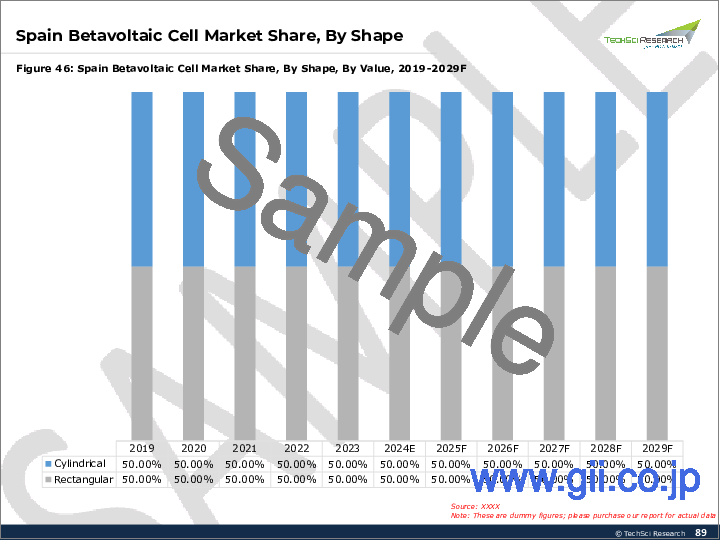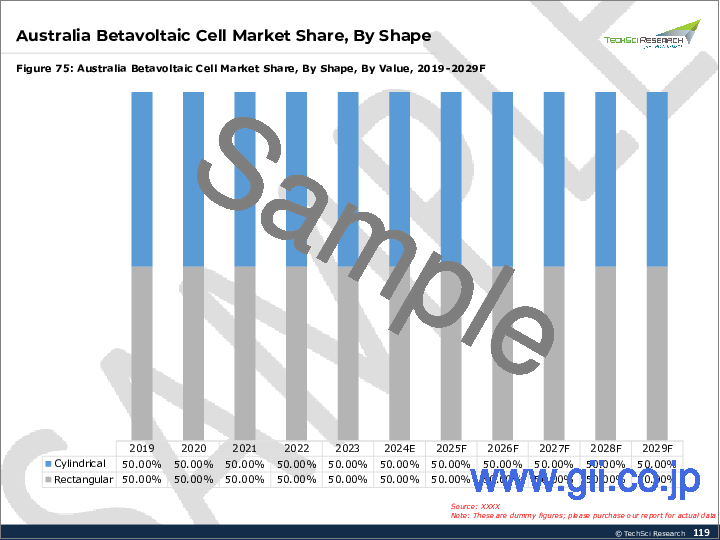|
|
市場調査レポート
商品コード
1262060
ベータボルタ電池市場- 世界の産業規模、シェア、動向、機会、予測、2018-2028年同位体種類別、形状別、エンドユーザー産業別、地域別、競合別Betavoltaic Cell Market - Global Industry Size, Share, Trends, Opportunity and Forecasted, 2018-2028 By Isotopes Type, By Shape, By End User Industry, By Region, By Competition |
||||||
|
● お客様のご希望に応じて、既存データの加工や未掲載情報(例:国別セグメント)の追加などの対応が可能です。 詳細はお問い合わせください。 |
|||||||
| ベータボルタ電池市場- 世界の産業規模、シェア、動向、機会、予測、2018-2028年同位体種類別、形状別、エンドユーザー産業別、地域別、競合別 |
|
出版日: 2023年04月01日
発行: TechSci Research
ページ情報: 英文 118 Pages
納期: 2~3営業日
|
- 全表示
- 概要
- 目次
ベータボルタ電池の世界市場は、予測期間である2023年から2028年にかけて安定したペースで成長し、堅実なCAGRで成長すると予測されています。
モバイル機器向けベータボルタ電池
同位体層とエネルギー変換層を積層したデザインを、モバイル機器やモバイルアプリ向けのベタボルテージ電源に搭載しました。同位体層の半減期は0.5~5年で、15~200keVのエネルギーを持つ放射線を発生します。ベタボルタ電源は、携帯ガジェットを動かすのに十分な電力を、その耐用年数にわたって供給するように設定されています。そのため、人口の増加に伴い、携帯端末の使用頻度が高くなり、そのニーズが高まっています。その結果、太陽電池市場は今後拡大し、大きなCAGRを記録することが予想されます。
高い市場ポテンシャルを持つ軍事・防衛分野と植え込み型医療機器が注目されるベータボルタ電池の消費量
ヘルスケア分野での顕著な採用が、ベータボルタ電池の市場拡大に大きく寄与しています。ベータボルタ電池は、外科手術やヘルスケアの分野で幅広く利用されています。植込み型医療機器の市場は、ペースメーカーや除細動器などの心臓植込み型に加え、いくつかの選択肢を提供しています。いくつかの医療機器製造会社は、ベータボルタ電池に大きく依存する、堅牢で拡張性のある、携帯可能な低電力デバイスの作成を好むことを示しています。生体内薬物送達システム、脳神経刺激装置、眼内・人工内耳、輸液ポンプの開発など、非常に魅力的な分野のほんの一部にすぎません。また、生体内電子医療タグや脳-コンピュータ・インターフェース・システムなども、ベータボルタ電池メーカーの応用分野として考えられています。さらに、防衛や軍事用途の分野でも多くの見込みがあります。ベータボルタ電池は、軍用機器の改ざん防止に大きな潜在的用途があると予想されます。この電池は、防衛分野(FPGA)に関連するRealm Programmable Gate Arraysの暗号化キーに効果的に電力を供給するかもしれません。
原子力電池とその他のベータボルタ電池の新しいアプリケーション研究への関心を引き続き促します。
原子力電池の業界最大の問題は、時間の経過とともに徐々に減少する速度でエネルギーを供給することです。さらに、作った電気を使わなければ、期限切れになってしまいます。これが太陽電池の弱点なのですが、メーカーはなかなかパワーアップに踏み切れませんでした。そこで、太陽電池の電力変換効率を向上させることで、太陽電池の可能性を最大限に引き出す研究が進められています。この電池は、小型デバイス市場に革命的な変化をもたらす電池として、ますます注目されています。今後数年間は、研究開発のさらなる強化がこの変革をサポートすると予想されます。
2020年8月、カリフォルニアに本拠を置くNDB社は、自分で充電できる原子力電池を発表しました。この電池は、特に人工ダイヤモンドのケーシングに封入された炭素14核廃棄物によって、28,000年という驚異的な寿命を持つとされています。NDBによると、このバッテリーは、電気自動車、カメラ、ドローン、携帯電話、その他のモバイル機器、家電、医療機器など、さまざまなガジェットを動かすことができるそうです。
ブリストル大学の学者が設立した会社は、2020年9月に核ダイヤモンドベタボルテック電池を製造する画期的な戦略を発表しました。アーケンライト社が実用化を目指しているエネルギー効率の高い(ダイヤモンドベースの)ベタボルタ電池技術により、デバイスの寿命はもしかしたら数十年に達するかもしれません。このダイヤモンドベタボルタ電池の背景にあるアイデアは、放射性廃棄物であるカーボ14を自立したエネルギー源に変えることです。この電池は、最終的には、直接電源を供給する機器における充電の必要性を代替する可能性があります。
利用可能なカスタマイズ
TechSciリサーチは、与えられた市場データをもとに、世界のベータボルタ電池市場レポートとして、企業の特定のニーズに応じてカスタマイズを提供します。本レポートでは、以下のカスタマイズが可能です:
会社情報
- 追加市場プレイヤー(最大5社)の詳細分析およびプロファイリング
目次
第1章 概要
第2章 調査手法
第3章 COVID-19が世界のベータボルタ電池市場に与える影響
第4章 エグゼクティブサマリー
第5章 VOC (顧客の声)
- ブランド認知度
- ベータボルタ電池の世界市場を選択するために考慮された要因
- ベータボルタ電池の世界市場における現在のニーズギャップ
第6章 ベータボルタ電池の世界市場展望
- 市場規模・予測
- 金額別
- 市場シェアと予測
- アイソトープの種類別(トリチウム、ストロンチウム、クリプトン、ニッケル、その他)
- 形状別(長方形、円筒形)
- エンドユーザー産業別(航空宇宙、電子・通信、ヘルスケア、防衛、その他)
- 地域別
- 企業別(2022年)
- マーケットマップ
第7章 アジア太平洋地域のベータボルタ電池市場の展望
- 市場規模・予測
- 金額別
- 市場シェアと予測
- アイソトープスの種類別
- シェイプ別
- エンドユーザー業界別
- 国別
- アジア太平洋:国別分析
- 中国
- 日本
- インド
- 韓国
- オーストラリア
第8章 北米のベータボルタ電池市場の展望
- 市場規模・予測
- 金額別
- 市場シェアと予測
- アイソトープスの種類別
- シェイプ別
- エンドユーザー業界別
- 国別
- 北米:国別分析
- 米国
- カナダ
- メキシコ
第9章 欧州の太陽電池市場の展望
- 市場規模・予測
- 金額別
- 市場シェアと予測
- アイソトープスの種類別
- シェイプ別
- エンドユーザー業界別
- 国別
- 欧州:国別分析
- ドイツ
- 英国
- フランス
- スペイン
- イタリア
第10章 中東・アフリカのベータボルタ電池市場の展望
- 市場規模・予測
- 金額別
- 市場シェアと予測
- アイソトープスの種類別
- シェイプ別
- エンドユーザー業界別
- 国別
- 中東・アフリカ:国別分析
- サウジアラビア
- UAE
- 南アフリカ
第11章 南米β太陽電池の市場展望
- 市場規模・予測
- 金額別
- 市場シェアと予測
- アイソトープスの種類別
- シェイプ別
- エンドユーザー業界別
- 国別
- 南米:国別分析
- ブラジル
- アルゼンチン
- コロンビア
第12章 市場力学
- 促進要因
- 代替電源の需要が高い
- セルの小型化・コンパクト化
- 宇宙産業への投資拡大
- 課題
- 高いコスト、限られた利用可能性、規制への懸念
- 原材料の不足
- サプライチェーンにおける混乱
第13章 市場動向と開拓
- ベータボルタ電池の変換効率向上について
- 宇宙産業での活用が進む
- 世界各国の政府別研究開発活動への投資の増加
- 技術の進歩
- 政府の取り組み
第14章 政策・規制の状況
第15章 企業プロファイル
- Widetronix Inc
- Qynergy Corporation
- City Labs Inc
- BetaBatt Inc
- Arkenlight
- Direct Kinetic Solutions
- NDB Inc
第16章 戦略的な提言
- 北米地域に重点
- アイソトープタイプへの注目
第17章 調査会社について・免責事項
Global Betavoltaic Cell Market is anticipated to grow at a steady pace in the forecast period, 2023-2028, and grow at a solid CAGR in the forecast period.
A betavoltaic device, also known as a betavoltaic cell or battery, is a form of nuclear battery that uses semiconductor junctions to convert beta particles (also known as electrons) generated from a radioactive source into electric current. Tritium, an isotope of hydrogen, is a frequent source. Betavoltaic systems employ a non-thermal conversion mechanism, turning the electron-hole pairs created by the ionization path of beta particles passing a semiconductor, comparing most nuclear power sources, which use nuclear radiation to generate heat which is then used to generate electricity. In low-power electrical applications, such as implanted medical devices or military and space applications, where longevity of the energy source is required, betavoltaic power sources (and the related technology of alpha voltaic power sources) are particularly compatible.
Betavoltaic power sources for mobile device applications
A stacked design of isotope layers and energy conversion layers is included in a betavoltaic power source for mobile devices and mobile apps. The half-lives of the isotope layers are between 0.5 and 5 years, and they produce radiation with energies ranging from 15 to 200 keV. The betavoltaic power source is set up to deliver enough power to run the portable gadget for the duration of its useful life. So, as the population grows, the need for mobile devices increases due to usage. Consequently, it is anticipated that the betavoltaic cell market will expand in the approaching year and register a significant CAGR in the projection.
Military & Defense Offer High Market Potential and Implantable Medical Devices Register Remarkable Betavoltaic Cell Consumption
Notable adoption by the healthcare sector has contributed significantly to the market expansion for betavoltaic cells. Betavoltaic batteries have a wide range of useful uses in the fields of surgery and healthcare. The market for implanted medical devices offers several options in addition to cardiac implantables like pacemakers and defibrillators. Several medical device manufacturing firms have shown a preference for creating robust, scalable, portable, low-power devices that rely heavily on betavoltaic cells. The development of in-vivo medication delivery systems, cerebral neurostimulators, intraocular and cochlear implants, and infusion pumps are only a few of the extremely appealing fields. Other possible application areas for betavoltaic battery manufacturers include in-vivo electronic medical tags and brain-to-computer interface systems. Additionally, there are many prospects in the fields of defense and military applications. Betavoltaic cells are anticipated to have a substantial potential application in tamper-proofing military equipment. These cells might effectively power the encryption keys in Realm Programmable Gate Arrays, which is relevant to the field of defense (FPGA).
Nuclear Batteries and Other New Applications for Betavoltaic Cells Continue to encourage interest in research.
The industry's biggest problem with nuclear batteries is that they provide energy at a rate that gradually decreases over time. Additionally, if the electricity created is not used, it expires. While this has always been the weak point of betavoltaic cells, manufacturers have had a difficult time upping the power. There has been significant, active research underway on improving the power conversion efficiency of betavoltaic batteries to meet this challenge and unlock the full application potential of these batteries. These cells are increasingly seen as the batteries that will bring a revolutionary change in the tiny device market. Further strengthening R&D initiatives are anticipated to support this transformation in the upcoming years.
In August 2020, the California-based NDB company released a nuclear battery that can recharge on its own. The battery supposedly lasts an astounding 28,000 years, especially with the carbon-14 nuclear waste that has been encapsulated in an artificial diamond casing. According to NDB, the battery can power a variety of gadgets, including electric cars, cameras, drones, cellphones, other mobile devices, household appliances, and medical devices.
A company founded by the University of Bristol academics presented a revolutionary strategy to produce nuclear diamond betavoltaic batteries in September 2020. A device's lifespan might possibly reach decades because of the energy-efficient (diamond-based) betavoltaic battery technology that Arkenlight Limited is working to commercialize. The idea behind this diamond betavoltaic battery is to turn the radioactive waste carbo-14 into a self-sustaining energy source. These batteries may eventually replace the necessity of the need for charging in directly powered devices.
Market Segmentation
The Global Betavoltaic Cell Market is divided by isotope type, shape, and end-user industry. Based on Isotopes Type, the market is divided into Tritium, Strontium, Krypton, Nickel, and Others. Based on Shape, the market is segmented into Rectangular and Cylindrical. Based on the End User Industry, the market is divided into Aerospace, Electronics & Communication, Healthcare, Defense, and Others.
Market Players
Major market players in the Global Betavoltaic Cell Market are: Widetronix Inc, Qynergy Corporation, City Labs Inc, BetaBatt Inc, Arkenlight, Direct Kinetic Solutions, and NDB Inc.
Report Scope
In this report, the Global Betavoltaic Cell Market has been segmented into the following categories, in addition to the industry trends, which have also been detailed below:
Global Betavoltaic Cell Market, By Isotopes Type:
- Tritium
- Strontium
- Krypton
- Nickel
- Others
Global Betavoltaic Cell Market, By Shape:
- Rectangular
- Cylindrical
Global Betavoltaic Cell Market, By End User Industry:
- Aerospace
- Electronics & Communication
- Healthcare
- Defense
- Others
Global Betavoltaic Cell Market, By Region:
- Asia-Pacific
- North America
- Europe
- Middle East & Africa
- South America
Competitive Landscape
Company Profiles: Detailed analysis of the major companies present in the Global Betavoltaic Cell Market.
Available Customizations
Global Betavoltaic Cell market report with the given market data, TechSci Research offers customizations according to a company's specific needs. The following customization options are available for the report:
Company Information
- Detailed analysis and profiling of additional market players (up to five).
Table of Contents
1. Product Overview
2. Research Methodology
3. Impact of COVID-19 on the Global Betavoltaic Cell Market
4. Executive Summary
5. Voice of Customers
- 5.1. Brand Awareness
- 5.2. Factors Considered for Choosing Global Betavoltaic Cell Market
- 5.3. Current Need Gaps in Global Betavoltaic Cell Market
6. Global Betavoltaic Cell Market Outlook
- 6.1. Market Size & Forecast
- 6.1.1. By Value
- 6.2. Market Share & Forecast
- 6.2.1. By Isotopes Type (Tritium, Strontium, Krypton, Nickel, and Others)
- 6.2.2. By Shape (Rectangular and Cylindrical)
- 6.2.3. By End User Industry (Aerospace, Electronics & Communication, Healthcare, Defense and Others)
- 6.2.4. By Region
- 6.2.5. By Company (2022)
- 6.3. Market Map
7. Asia-Pacific Betavoltaic Cell Market Outlook
- 7.1. Market Size & Forecast
- 7.1.1. By Value
- 7.2. Market Share & Forecast
- 7.2.1. By Isotopes Type
- 7.2.2. By Shape
- 7.2.3. By End User Industry
- 7.2.4. By Country
- 7.3. Asia-Pacific: Country Analysis
- 7.3.1. China Betavoltaic Cell Market Outlook
- 7.3.1.1. Market Size & Forecast
- 7.3.1.1.1. By Value
- 7.3.1.2. Market Share & Forecast
- 7.3.1.2.1. By Isotopes Type
- 7.3.1.2.2. By Shape
- 7.3.1.2.3. By End User Industry
- 7.3.1.1. Market Size & Forecast
- 7.3.2. Japan Betavoltaic Cell Market Outlook
- 7.3.2.1. Market Size & Forecast
- 7.3.2.1.1. By Value
- 7.3.2.2. Market Share & Forecast
- 7.3.2.2.1. By Isotopes Type
- 7.3.2.2.2. By Shape
- 7.3.2.2.3. By End User Industry
- 7.3.2.1. Market Size & Forecast
- 7.3.3. India Betavoltaic Cell Market Outlook
- 7.3.3.1. Market Size & Forecast
- 7.3.3.1.1. By Value
- 7.3.3.2. Market Share & Forecast
- 7.3.3.2.1. By Isotopes Type
- 7.3.3.2.2. By Shape
- 7.3.3.2.3. By End User Industry
- 7.3.3.1. Market Size & Forecast
- 7.3.4. South Korea Betavoltaic Cell Market Outlook
- 7.3.4.1. Market Size & Forecast
- 7.3.4.1.1. By Value
- 7.3.4.2. Market Share & Forecast
- 7.3.4.2.1. By Isotopes Type
- 7.3.4.2.2. By Shape
- 7.3.4.2.3. By End User Industry
- 7.3.4.1. Market Size & Forecast
- 7.3.5. Australia Betavoltaic Cell Market Outlook
- 7.3.5.1. Market Size & Forecast
- 7.3.5.1.1. By Value
- 7.3.5.2. Market Share & Forecast
- 7.3.5.2.1. By Isotopes Type
- 7.3.5.2.2. By Shape
- 7.3.5.2.3. By End User Industry
- 7.3.5.1. Market Size & Forecast
- 7.3.1. China Betavoltaic Cell Market Outlook
8. North America Betavoltaic Cell Market Outlook
- 8.1. Market Size & Forecast
- 8.1.1. By Value
- 8.2. Market Share & Forecast
- 8.2.1. By Isotopes Type
- 8.2.2. By Shape
- 8.2.3. By End User Industry
- 8.2.4. By Country
- 8.3. North America: Country Analysis
- 8.3.1. United States Betavoltaic Cell Market Outlook
- 8.3.1.1. Market Size & Forecast
- 8.3.1.1.1. By Value
- 8.3.1.2. Market Share & Forecast
- 8.3.1.2.1. By Isotopes Type
- 8.3.1.2.2. By Shape
- 8.3.1.2.3. By End User Industry
- 8.3.1.1. Market Size & Forecast
- 8.3.2. Canada Betavoltaic Cell Market Outlook
- 8.3.2.1. Market Size & Forecast
- 8.3.2.1.1. By Value
- 8.3.2.2. Market Share & Forecast
- 8.3.2.2.1. By Isotopes Type
- 8.3.2.2.2. By Shape
- 8.3.2.2.3. By End User Industry
- 8.3.2.1. Market Size & Forecast
- 8.3.3. Mexico Betavoltaic Cell Market Outlook
- 8.3.3.1. Market Size & Forecast
- 8.3.3.1.1. By Value
- 8.3.3.2. Market Share & Forecast
- 8.3.3.2.1. By Isotopes Type
- 8.3.3.2.2. By Shape
- 8.3.3.2.3. By End User Industry
- 8.3.3.1. Market Size & Forecast
- 8.3.1. United States Betavoltaic Cell Market Outlook
9. Europe Betavoltaic Cell Market Outlook
- 9.1. Market Size & Forecast
- 9.1.1. By Value
- 9.2. Market Share & Forecast
- 9.2.1. By Isotopes Type
- 9.2.2. By Shape
- 9.2.3. By End User Industry
- 9.2.4. By Country
- 9.3. Europe: Country Analysis
- 9.3.1. Germany Betavoltaic Cell Market Outlook
- 9.3.1.1. Market Size & Forecast
- 9.3.1.1.1. By Value
- 9.3.1.2. Market Share & Forecast
- 9.3.1.2.1. By Isotopes Type
- 9.3.1.2.2. By Shape
- 9.3.1.2.3. By End User Industry
- 9.3.1.1. Market Size & Forecast
- 9.3.2. United Kingdom Betavoltaic Cell Market Outlook
- 9.3.2.1. Market Size & Forecast
- 9.3.2.1.1. By Value
- 9.3.2.2. Market Share & Forecast
- 9.3.2.2.1. By Isotopes Type
- 9.3.2.2.2. By Shape
- 9.3.2.2.3. By End User Industry
- 9.3.2.1. Market Size & Forecast
- 9.3.3. France Betavoltaic Cell Market Outlook
- 9.3.3.1. Market Size & Forecast
- 9.3.3.1.1. By Value
- 9.3.3.2. Market Share & Forecast
- 9.3.3.2.1. By Isotopes Type
- 9.3.3.2.2. By Shape
- 9.3.3.2.3. By End User Industry
- 9.3.3.1. Market Size & Forecast
- 9.3.4. Spain Betavoltaic Cell Market Outlook
- 9.3.4.1. Market Size & Forecast
- 9.3.4.1.1. By Value
- 9.3.4.2. Market Share & Forecast
- 9.3.4.2.1. By Isotopes Type
- 9.3.4.2.2. By Shape
- 9.3.4.2.3. By End User Industry
- 9.3.4.1. Market Size & Forecast
- 9.3.5. Italy Betavoltaic Cell Market Outlook
- 9.3.5.1. Market Size & Forecast
- 9.3.5.1.1. By Value
- 9.3.5.2. Market Share & Forecast
- 9.3.5.2.1. By Isotopes Type
- 9.3.5.2.2. By Shape
- 9.3.5.2.3. By End User Industry
- 9.3.5.1. Market Size & Forecast
- 9.3.1. Germany Betavoltaic Cell Market Outlook
10. Middle East & Africa Betavoltaic Cell Market Outlook
- 10.1. Market Size & Forecast
- 10.1.1. By Value
- 10.2. Market Share & Forecast
- 10.2.1. By Isotopes Type
- 10.2.2. By Shape
- 10.2.3. By End User Industry
- 10.2.4. By Country
- 10.3. Middle East & Africa: Country Analysis
- 10.3.1. Saudi Arabia Betavoltaic Cell Market Outlook
- 10.3.1.1. Market Size & Forecast
- 10.3.1.1.1. By Value
- 10.3.1.2. Market Share & Forecast
- 10.3.1.2.1. By Isotopes Type
- 10.3.1.2.2. By Shape
- 10.3.1.2.3. By End User Industry
- 10.3.1.1. Market Size & Forecast
- 10.3.2. UAE Betavoltaic Cell Market Outlook
- 10.3.2.1. Market Size & Forecast
- 10.3.2.1.1. By Value
- 10.3.2.2. Market Share & Forecast
- 10.3.2.2.1. By Isotopes Type
- 10.3.2.2.2. By Shape
- 10.3.2.2.3. By End User Industry
- 10.3.2.1. Market Size & Forecast
- 10.3.3. South Africa Betavoltaic Cell Market Outlook
- 10.3.3.1. Market Size & Forecast
- 10.3.3.1.1. By Value
- 10.3.3.2. Market Share & Forecast
- 10.3.3.2.1. By Isotopes Type
- 10.3.3.2.2. By Shape
- 10.3.3.2.3. By End User Industry
- 10.3.3.1. Market Size & Forecast
- 10.3.1. Saudi Arabia Betavoltaic Cell Market Outlook
11. South America Betavoltaic Cell Market Outlook
- 11.1. Market Size & Forecast
- 11.1.1. By Value
- 11.2. Market Share & Forecast
- 11.2.1. By Isotopes Type
- 11.2.2. By Shape
- 11.2.3. By End User Industry
- 11.2.4. By Country
- 11.3. South America: Country Analysis
- 11.3.1. Brazil Betavoltaic Cell Market Outlook
- 11.3.1.1. Market Size & Forecast
- 11.3.1.1.1. By Value
- 11.3.1.2. Market Share & Forecast
- 11.3.1.2.1. By Isotopes Type
- 11.3.1.2.2. By Shape
- 11.3.1.2.3. By End User Industry
- 11.3.1.1. Market Size & Forecast
- 11.3.2. Argentina Betavoltaic Cell Market Outlook
- 11.3.2.1. Market Size & Forecast
- 11.3.2.1.1. By Value
- 11.3.2.2. Market Share & Forecast
- 11.3.2.2.1. By Isotopes Type
- 11.3.2.2.2. By Shape
- 11.3.2.2.3. By End User Industry
- 11.3.2.1. Market Size & Forecast
- 11.3.3. Colombia Betavoltaic Cell Market Outlook
- 11.3.3.1. Market Size & Forecast
- 11.3.3.1.1. By Value
- 11.3.3.2. Market Share & Forecast
- 11.3.3.2.1. By Isotopes Type
- 11.3.3.2.2. By Shape
- 11.3.3.2.3. By End User Industry
- 11.3.3.1. Market Size & Forecast
- 11.3.1. Brazil Betavoltaic Cell Market Outlook
12. Market Dynamics
- 12.1. Drivers
- 12.1.1. High Demand for Alternative Power Supply
- 12.1.2. Compact and Small Size of the Cells
- 12.1.3. Increasing Investments in the Space Industry
- 12.2. Challenges
- 12.2.1. High Costs, Limited Availability and Regulatory Concerns
- 12.2.2. Shortage of raw material
- 12.2.3. Disruption in the supply chain
13. Market Trends & Developments
- 13.1. Increasing Conversion Efficiency of Betavoltaic Cells
- 13.2. Increasing use in the space industry
- 13.3. Increasing investment by various governments across the globe in R&D Activities
- 13.4. Technological Advancement
- 13.5. Government Initiatives
14. Policy & Regulatory Landscape
15. Company Profiles
- 15.1. Widetronix Inc
- 15.1.1. Business Overview
- 15.1.2. Key Revenue and Financials (If Available)
- 15.1.3. Recent Developments
- 15.1.4. Key Personnel
- 15.1.5. Key Product/Services
- 15.2. Qynergy Corporation
- 15.2.1. Business Overview
- 15.2.2. Key Revenue and Financials (If Available)
- 15.2.3. Recent Developments
- 15.2.4. Key Personnel
- 15.2.5. Key Product/Services
- 15.3. City Labs Inc
- 15.3.1. Business Overview
- 15.3.2. Key Revenue and Financials (If Available)
- 15.3.3. Recent Developments
- 15.3.4. Key Personnel
- 15.3.5. Key Product/Service
- 15.4. BetaBatt Inc
- 15.4.1. Business Overview
- 15.4.2. Key Revenue and Financials (If Available)
- 15.4.3. Recent Developments
- 15.4.4. Key Personnel
- 15.4.5. Key Product/Service
- 15.5. Arkenlight
- 15.5.1. Business Overview
- 15.5.2. Key Revenue and Financials (If Available)
- 15.5.3. Recent Developments
- 15.5.4. Key Personnel
- 15.5.5. Key Product/Services
- 15.6. Direct Kinetic Solutions
- 15.6.1. Business Overview
- 15.6.2. Key Revenue and Financials (If Available)
- 15.6.3. Recent Developments
- 15.6.4. Key Personnel
- 15.6.5. Key Product/Services
- 15.7. NDB Inc
- 15.7.1. Business Overview
- 15.7.2. Key Revenue and Financials (If Available)
- 15.7.3. Recent Developments
- 15.7.4. Key Personnel
- 15.7.5. Key Product/Services
16. Strategic Recommendations
- 16.1. Key focus on North America Region
- 16.2. Key focus towards Isotopes Type




